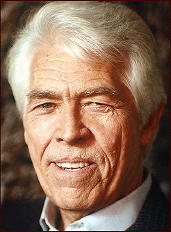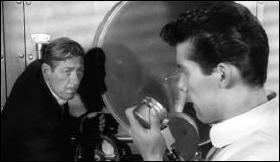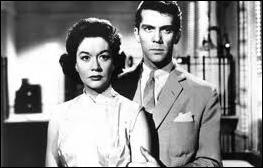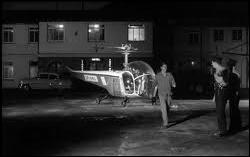A FORGOTTEN TV SERIES REVIEW
by Michael Shonk
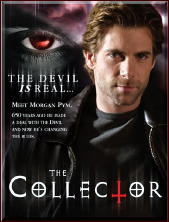
THE COLLECTOR. Syndicated: Canada, A No Equal Entertainment Inc Production, 2004-2006. 40 episodes, 60 minutes each. Cast: Chris Kramer as Morgan Pym, Carly Pope (Season One and one episode of Season Two) Sonya Salomaa (Season Two and Three), Aidan Drummond as Gabe, Christine Chatelain as Taylor Slate, Ellen Dubin as Jeri Slate, Andrew Jackson as Danny Hullstrom and Ona Grauer as Katrina. Creators and Executive Producers: Jon Cooksey and Ali Marie Matheson. Executive Producer: Larry Sugar.
After several centuries of collecting souls for the Devil, Morgan Pym convinces The Devil to let him have 48 hours to help the client redeem their soul before the Devil takes them.
Most forgotten series are forgotten for a reason, but The Collector is one of those few that deserved a better fate. Apparently it did not make a deal with the Devil since the series lasted a too short three years instead of the standard Devil deal for ten years.
Morgan Pym was originally a 14th century monk who breaks his vows when he falls in love with Katrina, a woman in the village. When Katrina dies of the plague, Morgan sells his soul for her to return to life, only to see her die a second time ten years later. This time the Devil offers Morgan the chance to be his first collector of souls.
When Morgan would get a new client from the Devil, he would have forty-eight hours to help the client redeem his or her soul. Time limits are a good device to increase suspense and tension in a drama, but The Collector went further.
Morgan did not always win, some times he did not want to save the soul but to hurry the client to Hell for the sake of others, some times the Devil would distract him or trick him from his goal. All of this made for something rare in a weekly TV series — the viewers never knew how each episode would end.

Not only were the endings uncertain, the episodes varied from comedic to theological to tragic to mystic to historic to almost any type of drama. The Collector was less interested in religion and more about the human condition. The series focused on questions such as why the client sold his or her soul, how the Devil used the request to increase the suffering of others, and how can the client with Morgan’s help redeem themselves in less than 48 hours.
The acting and production values were generally average, with star Chris Kramer one of the weakest parts of the series. But the characters and the depth of each backstory were a major strength of The Collector.
For the most part, each episode told a separate and complete story featuring the client of the week. However, some stories took time out from the main story to explore a subplot involving a young, apparently autistic boy named Gabe.
The series takes place in modern day Vancouver. Morgan lives in a rundown apartment building and has a time traveling motorcycle in his room. Now a servant of the Devil, he has a very human like love/hate relationship with a God who let the love of his life die (twice).
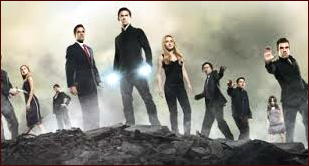
His neighbor neurotic Maya is a junkie who falls for Morgan in Season One. Morgan tries to help her get her life together but still mourns for Katrina and resists a romantic relationship with Maya. In the first episode of Season Two there is a surprise dramatic twist that results in a new actress taking over the role. Maya and Morgan’s relationship would continue to grow more serious during the rest of the series.
Local reporter Jeri Slate becomes obsessed with discovering the true identity of Morgan to the point of neglecting her son Gabe. Despite the efforts of her sister Taylor who takes care of Gabe, Jeri falls deeper and deeper into her obsession until it consumes her.
Gabe is a sullen young boy (who turned ten in season three) with unknown powers. Withdrawn and refusing to talk Gabe can draw crude pictures of events before they happen, perhaps even causing them.
When we finally learn the fate of Gabe’s father Danny Hullstrom, it deepens the mystery of Gabe. Gabe begins to search for his role, his place in life. Gabe is the only one besides Morgan who can see through the Devil’s disguises. The Devil tries to influence Gabe as his pictures often ruin the Devil’s plans. The scenes with Gabe are separate from the main story. Gabe may control the events but Morgan and the clients are not aware of it.
The Devil is the series’ most fun character, especially when played by Colin Cunningham who does the opening narration in every episode and the actor to appear as The Devil the most. A variety of actors and actress would play the part as the series had fun with the ability of The Devil to appear anywhere and as anyone including characters from past episodes.
The series ended after Season Three and left many lose ends. Why was The Devil willing to let Morgan try to help redeem his clients just at the moment he could claim them? Who is Gabe and what was his role? What would happen to those Morgan saved, how would they handle the truth about The Devil and the World?
Whether you are religious or not (I’m not) I recommend you check out this series.
Our YouTube examples (for as long as they last) include one episode from each season. First is episode six, the first time we see Gabe in action.
“The Actuary.” Written by Frank Borg. Directed by Holly Dale. Guess Cast: Rob Labelle, Alex Diakun, David Ward and Ben Ayres as the Devil. *** Client of the week is Barrett Gimbel, an Actuary who works for the local mob. Barrett had sold his soul for a machine that tells how and when anyone dies. In this funny episode the mob boss learns that the machine has said he will die tomorrow and Barrett will kill him. In a mysterious sad counterpoint we meet reporter Jill’s neglected son Gabe.
https://www.youtube.com/watch?v=8LqCG2T4V0g
In Season Two “The Mother” is an important episode in the Gabe storyline, but our example is the last episode of Season Two. This is one of the best episodes of the series as we watch Morgan learn on the job as the Devil assists him on his first collection.
“The Beginnings.” Written by Jon Cooksey and Ali Marie Matheson. Directed by J.B. Sugar. Guest Cast: Gabriel Hogan, Alan Peterson, Ona Grauer, and Colin Cunningham as the Devil. *** It is the 14th century and things look dark for humanity as the plague sweeps over the known world. Morgan and Katrina live and love. Katrina is burdened with guilt for having survived the plague while so many others have died. Morgan never tell her that he had sold his soul to save her. The ten years pass quickly and Katrina dies again. The Devil arrives and instead of Hell offers Morgan the chance to become his first collector of souls.
https://www.youtube.com/watch?v=sxWcGb2VDwk
Finally, an example of the diversity of clients and type of stories this series told. Season Three, Episode Eleven is a good spy thriller. It is also a more typical episode as it is without the Gabe subplot. For those seeking the last episode of the Gabe subplot check out “The Media Baron.”
“The Spy.” Written by Jon Cooksey and Ali Marie Matheson. Directed by J.B. Sugar. Guest Cast: Joely Collins, Martin Cummins, Wanda Cannon and Alisen Down as the Devil. *** Kandyse Crown time ends in two days and she is still trying to finish the mission she sold her soul to complete. The Devil is a female Eastern European filmmaker who is famous for her films inspiring despair and depression — a nice jab at the era’s typical Eastern Europe film style.
https://www.youtube.com/watch?v=LrF0A9I1g3g
The third season of The Collector third season has never been released on DVD, and the DVDs of the first two seasons are out of print.
YouTube offers (at this time) all fourteen episodes of Season One, and the thirteen episodes each of Season Two and Three.
UPDATE [02-06-25]: All of the videos Michael linked to when he wrote this review appear now to be defunct.
